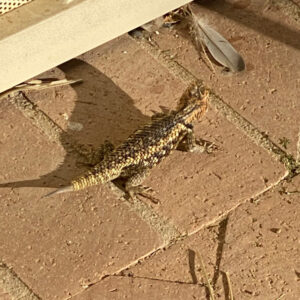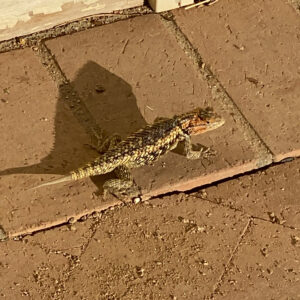After writing a couple of books about reptiles (Don’t Call Me Turtle! and Don’t Make Me Rattle!), I wrote a book about roadrunners. I’m not sure why I was so inspired, except for their impact on the reptiles, as significant predators. I delight in the variety and numbers of lizards (and snakes) that have chosen to live in my yard, so I worry when I see a feathered lizard predator running around. I want my backyard to be a reptile haven, not a roadrunner fast food stop! Find out what I mean.
My Roadrunner Drive-thru
Roadrunners are interesting-looking birds running around with that long tail, heads stretched forward, intently looking for a reptilian meal. I often see them in my yard, but even if I don’t see them, I know they’ve been there. First, the lizard population seems reduced. I have my regulars that I see daily. Suddenly, they don’t come out to greet me. Has my socialization with them endangered them? Surely, they can tell the difference between me and a roadrunner, right?
After a roadrunner visit, many of the lizards in my backyard show damage from their avian encounters. Fortunately, my local lizards have an autotomic superpower. Autotomy is the ability to detach a body part, like a tail, to save the lizard’s life. Better to lose a tail instead of your life. When the tail is “dropped,” the blood vessels are clamped shut so the lizard won’t bleed to death. Now in the roadrunner’s mouth, the tail wiggles to distract the bird. The lizards that have their tails ripped off do suffer extreme injuries.
Would You Like a Tail with That?
Recently, a roadrunner came to my yard for lunch. Several of my favorite lizard friends appeared missing portions of their tails the next morning! As I watched, over the next few days, their tails began to regenerate. That’s the fantastic thing about autotomy. Not only can lizards drop their tails to thwart a predator, but then they regrow the tail! It’s not as lovely as the original tail, but relatively functional.
Below is one of my lizards a few days after the roadrunner encounter. His tail is already starting to regenerate.

A few days later, you can see his regeneration progressing well.

Notice that the tail is solid brown. It doesn’t have the excellent scaling and color pattern as the original tail tissue. That’s because the new growth is primarily cartilaginous. Instead of bone with regular spacing, the unique vertebrae are produced as a single unsegmented tube. The blood vessels pass through pores in the cartilage tube. Some nerves from the natural tail extend into regenerated tissue. So, while reasonably functional, the new tail differs from the original.
I’m happy to report that the lizard in the photograph and the other tail-loss lizard victims are recovering and regenerating from their roadrunner encounters. I hope the roadrunner learned that the reptiles in my yard aren’t worth hunting since they will only get tail pieces to eat. Predators are welcome to visit, but I prefer they dine elsewhere. Maybe try a McDonalds?
